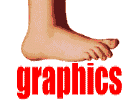 
How to reduce Web image file size
- a review of the software
Preamble
As these pages hadn't been updated for several months, I wrote some new stuff
here until I could get things better organised. Take
a look for the latest information. Since then, I've also updated some of the reviews:
see the red asterisked entries below. DN
March 1999
Whys and wherefores
If you're visiting this website over a slow link you will know that graphics can take a long time to download at times. So it makes plenty of sense for Web page designers to minimise the size of the graphics images they use. These pages are intended as a review of the software that is available to do this work.
Most graphics generation programs like Photoshop and PaintShop Pro allow some degree of control over image compression, be the file a GIF or a JPEG. But programs designed for use in the print medium usually have not been optimised for minimum image size. Generally in the print industry, the objective is the best image quality and image size is nearly irrelevant. But the Web is a very different matter: file size is just as important as image quality. So a small industry has grown up in the last two years for add-ons to the main graphics software applications, principally Photoshop, to provide greater control over the size of graphic images destined for the Web.
I've found no single source of information on all the different programs available to do the job. Even finding the information is difficult. At best the current on-line reviews seem to tackle one or two packages, which makes comparison tricky. So the reviews in these pages are the result of my own investigations. They are directed at the small stand-alone applications and graphics program plugins, not the graphics programs themselves. I've concentrated on Windows95 software, but in most cases what is available for Win95/NT is also available for the Mac. So hopefully the reviews will be of general interest.
What I've found
There are two sorts of programs I've found on my travels. The main type is the program that takes an image file - JPEG or GIF - and compresses it as much as possible without unduly distorting it, while taking into account the colour display limitations of some browser/PC combinations. I've found nine such programs so far. The second type is a program that generates synthetic palettes using the limited 256 colour palete available to VGA graphics cards. There are two of these programs I've found so far.
I've been testing the applications as plugins for Adobe Photoshop 4.0 and PaintShop Pro 4.1, as well as stand alone applications. Usually the filter type plugins work with both, but the export plugins work only with Photoshop.
What this is not about, and disclaimer
Needless to say, the work here reflects my own personal views, and should not in any way be taken to construe fitness or otherwise of any piece of software for any particular purpose. It's merely an account of my explorations and opinions. I'm not going to tell you what the best program is, because that depends on your own tastes and what you want to achieve. What I will recount is what I think about the programs, for my own purposes. For the record, I started out looking for a program that would do a good job compressing the graphics on my own Web pages. And I've not yet subjected all my graphics to the programs I found, that will come in due course. (I got distracted onto this ...)
How I've judged the programs
Perhaps I should also say a word or two about what I look for in programs that optimise JPEGs and GIFs.
First, JPEGs. In my youth I devoted a good deal of time to photography (I still do when I can). So I come to graphics compression and optimisation with a photographer's preoccupation for sharpness, colour fidelity, and a hatred of stray marks, spots etc on an image.
This, of course, makes me rather critical of over-compressed JPEG files. I get very distressed by colour smearing, or block blotchiness in areas supposed to be smooth transitions of colour, and, especially, the little "wrinkly" artifacts that show up near high contrast edges in an image. In the absence of other concerns, I'm probably a lot fussier than many about these things. My dilemma arises from the fact that, having a website in .AU, I'm aware that some overseas visitors may find the download time for the images I use to be very tiresome. So I'm caught between wanting clean, sharp images and the need to avoid slow downloads. I think everyone who puts images on a website confronts this dilemma. I felt I should indicate that I've strived for clean images as my first priority, and that I judge compression programs with this as my preoccupation.
GIF compression is less of a worry. You generally don't find anyone trying to use GIFs to reproduce photographic images, as the result, while often quite good, yields a file that is much larger than a JPEG of equivalent quality. So what I look for in a GIF compressor is smallness of the output file, consistency in retaining a colour value in the compressed file, the ability to generate a good image using the "web-safe" palette, and a sensible choice of appropriate colours from that palette.
Finally, I'm still a bit worried about how many people come to my site using video diplays set to 256 colours. As I write this (Jan 5th), I know my main page looks absolutely horrible in 256 colours. It's something I'm working on.
The good oil
These are the programs I've looked at so far, and here's where to find the information:
*
- a review added or updated in the last month
What's still needed
One of the problems Web page designers face is the different systems
visitors will use to view their pages. There are Windows machines, Macs,
monochrome screens and Unix systems (and Atari, and Acorn ...). Among
the Windows machines there are those with decent graphics cards that
provide 16 or 24-bit colour, and older systems that only allow 256 colours.
And on top of that are the different browser palettes.
When I started these pages last year, what was needed was a program that would
let the page designer look at the graphics and simulate the different viewer platforms.
By this I mean seeing what an image will look like with a graphics system set
to 256 colours (or - Heaven forfend - 16!). Simulating the different gamma settings
for Macs and PCs would be nice, too. That way image modifications could be made
in the full knowledge of what the viewer will see. Well, this is now available.
Cyberview does it for JPEGs. You can see
what the image will look like when dithered to 8-bit colour by either
MSIE or Netscape.
Adobe ImageReady allows you to preview any image
in 256 colours with dithering of your choice. You just select the GIF preview
with "web-safe" colours and you'll see what any image is going to look
like in a 256 colour system. ImageReady also has a Mac/PC gamma preview.
Ignite also has a 256 colour and Mac gamma preview.
It's as simple as clicking a button on the toolbar. The preview gamma level can
be set by the user, too. You can't ask for better than that.
... And some links
For good measure, here are some very good links to information about web graphics compression, palettes and related matters of interest.
Back to the main entry page
Last updated: 20 March 1999
This information is
Copyright © 1997,98,99 David Nicholls. These pages may be linked to, provided
you don't embed them in frames, but may not be reproduced in any form without
permission in writing from the author. [Last pdate? 18June98]
How many people have come this way? 
| 


